09 August 2024
2024 fertiliser N performance during a difficult grass-growing year

There has been much debate as to why grass was not growing as anticipated during the last 4 months with many theories put forward as to the reasons why. Research from Teagasc, Johnstown Castle compares the performance of different nitrogen fertiliser types in this challenging environment.
Weather factors affecting grass growth during 2024
One of the primary reasons were the weather conditions especially over the first 6 months of 2024, which have proved less than ideal for grass growth on farms. Met Eireann describe April as wet with as above average rainfall, and May as being dull. According to Met Eireann June and July were the coldest since June 2015 and July 2020 respectively. Recorded grass growth rates during the peak grass growing months (April to June) have been lower than average. Total grass growth, recorded on PastureBase Ireland, was reduced by 1.2 tonnes Dry Matter per hectare up to 3rd July 2024. This has placed additional management pressures on farmers in order to provide sufficient quality feed in front of grazing animals, and also to replenish fodder stocks during the height of the grass growing season.
Changes in types of fertiliser N applied
An area that has received considerable discussion in recent months has been the type of fertiliser N applied. Over the last 3 years in particular, the fertiliser industry has supplied more urea based N fertiliser products and with a growing proportion of this urea based N protected with NBPT type inhibitors (protected urea). This has been driven by geopolitical issues affecting energy and trade and also the national effort to reduce gaseous emissions from the agricultural sector. In a year of lower grass growth, questions have surfaced about the performance and efficacy of different fertiliser N forms.
Grass yield response to different fertiliser N types
The long-term grassland nitrogen fertiliser type experiment at Teagasc, Johnstown Castle provides very valuable insights to the performance of a large range of fertiliser N types. This field trial has been running for over 10 years and compares fertiliser N types in a head-to-head manner. Grass yield results for 5 of the most widely used fertiliser N types are compared and shown – CAN, Urea, and protected urea products (NBPT Urea, NBPT + NPPT Urea and 2 NPT Urea). All fertiliser types were applied at the same rate of N and at the same timings throughout the growing season. The grass yield and N recovery are measured at defined times over the growing season.

Figure 1. Grass dry matter yield for the different fertiliser N types over four periods during 2024.
The grass growth response to the different N types for the 2024 season to date are shown in figure 1. The first grass yield measurement was delayed until 22nd April and showed that the protected urea products produced grass yields at least similar, if not higher, than CAN and Urea fertilisers in the early period of the 2024 season.
The second measurement was taken one month later on 22nd May and showed that grass yields were similar across all the fertiliser N types. It should be noted that overall there was a poor response to applied N, regardless of the fertiliser N type, at an average 9 kg DM /ha per Kg N fertiliser applied. This was due to the effect of wet and waterlogged soils during late April and into May.
The third measurement of grass growth response to the fertiliser N types was taken on 25th June. There were reasonable grass growing condition during this period. The results from the head to head comparisons of the fertilisers types show similar yield performance. The average response to applied fertiliser N in this period was 25kg DM/ha per kg N applied.
The fourth measurement of grass growth response to the fertiliser N types was taken after a further months growth on 23th July. The first observation during this period was very poor levels of grass growth regardless of the fertiliser N type with an average response of 12 kg DM per kg N applied. Overall, there was no difference between the different fertiliser types during this period. A similar experience for this period was observed on farms where grass growth rates were extremely low with daily growth rates as low as 20 to 25kg DM/ha/day reported.
Overall when the total grass yields produced to date in 2024 for the different fertiliser N types are compared there was no significant difference observed (figure 2). As an alternative to the more traditional fertiliser N types used on Irish farms in the past (CAN and Urea), protected urea fertiliser continues to perform under a range of conditions including the very challenging conditions presented in 2024 to date.

Figure 2. Cumulative grass dry matter yield for the different fertiliser N types up to the 23rd July 2024.
